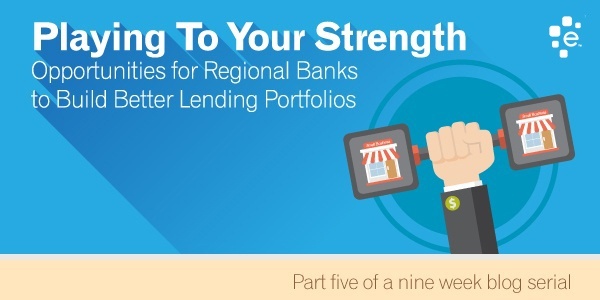| This week, we invited Charles H. Green to offer his perspectives on the online marketplace lending sector. Charles is Managing Director of Small Business Finance Institute, which provides professional training to commercial lenders for banks and nonbanks. He has written extensively about the marketplace lending sector, including the recent Banker’s Guide to New Small Business Finance (John Wiley & Sons, 2014). Earlier in his career, he founded and served as President/CEO of Sunrise Bank of Atlanta. |

The evolution of commercial lending over the past seven years has certainly had its share of ups and downs. Remember the ominous days leading up to the financial crisis when it seemed like everything was teetering on collapse? In the end, and more than five hundred bank failures later, the economy found a very slow path back to growth.
During that uncertain time, commercial lenders took a lot of criticism from several directions. Regulators were skeptical of the risk level that lenders accepted, borrowers argued when their credit score did not qualify them for a loan and seemingly everyone else had an opinion on how long it took to turn lending volumes around. On top of those worries, a new channel emerged, “online marketplace lending.” These new lenders funded loans from technology platforms that turned around loan applications in very short order, seeming to best banks at their own game.
Fast forward several years, and traditional lending has had plenty to cheer about, even if not recognized in the broader economy. The bank failures largely have been resolved, making some of the healthy surviving banks much larger and eliminating some competitors in many markets. Additionally, bank profits are back up as balance sheets have been mostly cleared of underperforming credits, with a renewed focus on good underwriting and solid risk management.
Banks Have Advantages
This new phenomenon known as online marketplace lending has grown dramatically on the strength of loans that traditional banks have had difficulty serving in the past: small, unsecured working capital loans to service and retail businesses. By performing the sorely needed task of scaling smaller business loans, online marketplace lenders have strengthened many small companies that were otherwise unable to secure financing from banks.
However, banks never lost their core strength: their customers. While deregulation gave rise to competitors from a long list of bank services and products, few small-business owners left their banks behind entirely. During the crisis, many companies flocked back to the safety of the federally insured deposit system. Online marketplace lenders may augment but never replace those kinds of relationships.
Another advantage large banks have is a strong tie with local businesses. While online lenders can respond quickly to application requests with the latest digital efficiency, their capacity to forge direct relationships is often limited to the term of their outstanding loan. Once repaid, they must restart the cycle to convince clients to borrow again.
Banks, on the other hand, offer dozens of products and services that can help small business owners manage everything from business finances, household purchases, retirement savings, auto loans, safe deposit boxes, etc. Most online lenders offer a shorter product list, with options intended to serve a specific customer demographic.
Perhaps the most significant advantage banks carry is their degree of flexibility. While online marketplace lenders can leverage the many benefits of a digital platform, there is often only one way to apply for a loan. Many online lenders lose business when an applicant falls outside their parameters.
Finally, banks offer flexibility to negotiate around certain conditions or requirements that may bear consideration of alteration. There are people at various levels who can waive some rules or make exceptions when warranted.
Given their similarities (looking for business among the same customer prospects) and differences (average loan size, structure and underwriting), banks and online marketplace lenders have the perfect opportunity to forge cooperative arrangements to exchange business.
Imagine there is a bank president with a 50 percent loan-to-deposit ratio who is starved for a larger book of earning assets. Perhaps he needs assets from some areas that came up weak in his Community Reinvestment Act (CRA) examination? Maybe his loan product mix is too heavily reliant on big Commercial Real Estate (CRE) loans, but he struggles to book small credits profitably due to the boarding cost?
What if he could go to a trusted online marketplace dashboard and search for loans to buy based on a transparent credit grading matrix, with adequate returns commensurate with the risk? Maybe he could even target specific ZIP™ codes to invest funds in places he is lacking market presence. Small-business loans, consumer loans, student loans — they’re all there, and more lines are on the way.
Online lenders are nonbank entities that finance much in the same way as banks. A considerable portion of their capital must be invested in their proprietary digital capacity, so when lending grows, many are scrambling for funding. Most of them fund this volume with either revolving lines of credit, securitization or by selling off loans/portfolios to investors.
The interesting part is that nothing should stop a commercial bank from participating in any of these activities.
There are plenty of opportunities for banks to engage with the marketplace for profitable results with manageable risk. Banks can buy portfolios or loans, refer loan applicants, use the online lender’s proprietary technology to underwrite and fund certain loans, or participate with lender finance, which has been a common practice for alternative lenders for decades.
Each type of financial institution has its own inherent advantages. However, playing to the strengths of the online marketplace and banks alike enables both types of entities to open new pockets of opportunity — a situation that may lead to a faster path for economic growth.
Related articles
Just how alternative are today’s online marketplace lenders?
How online marketplace lenders are changing the rules of small-business finance
Self-Regulatory Program for Nonbank Small Business Lenders
Top regulatory priorities for commercial lenders
Playing to Your Strength – Opportunities for Regional Banks to Build Better Lending Portfolios
Game Changer – How Marketplace Platforms Are Bringing Financial Institutions Back to Small-Business Lending
Marketplace Matchmakers – How Loan Aggregators Bring Borrowers and Lenders Together
New Frontiers – What’s Next For Marketplace Lending?
